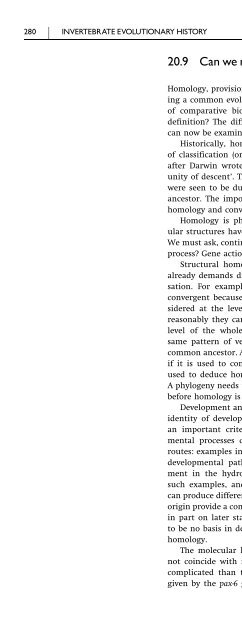An Introduction to the Invertebrates, Second Edition - tiera.ru
An Introduction to the Invertebrates, Second Edition - tiera.ru
An Introduction to the Invertebrates, Second Edition - tiera.ru
You also want an ePaper? Increase the reach of your titles
YUMPU automatically turns print PDFs into web optimized ePapers that Google loves.
280 INVERTEBRATE EVOLUTIONARY HISTORY20.9 Can we now define homology?Homology, provisionally defined as similarity in morphology reflectinga common evolutionary origin, is said <strong>to</strong> be <strong>the</strong> central concep<strong>to</strong>f comparative biology. Can we give it more than a superficialdefinition? The difficulty indicated at <strong>the</strong> beginning of Chapter 2can now be examined.His<strong>to</strong>rically, homology is a pre-Darwinian concept. The processof classification (ordering) of organisms acquired new significanceafter Darwin wrote, ‘On my <strong>the</strong>ory, unity of type is explained byunity of descent’. The resemblances on which classification is basedwere seen <strong>to</strong> be due <strong>to</strong> descent with modification from a commonances<strong>to</strong>r. The importance and difficulty of distinguishing betweenhomology and convergence soon became recognised as paramount.Homology is phylogenetic continuity, recognised where particularst<strong>ru</strong>ctures have been established and maintained by evolution.We must ask, continuity of what? Of st<strong>ru</strong>cture alone? Developmentalprocess? Gene action?St<strong>ru</strong>ctural homology, <strong>the</strong> sole basis of <strong>the</strong> original definition,already demands discrimination between different levels of organisation.For example, <strong>the</strong> wings of birds and bats can be calledconvergent because <strong>the</strong>y are very differently const<strong>ru</strong>cted and, consideredat <strong>the</strong> level of wings, have no common ances<strong>to</strong>r. Equallyreasonably <strong>the</strong>y can be called homologous when considered at <strong>the</strong>level of <strong>the</strong> whole animal, because <strong>the</strong>y have evolved from <strong>the</strong>same pattern of vertebrate forelimb, and that can be traced <strong>to</strong> acommon ances<strong>to</strong>r. A major problem with st<strong>ru</strong>ctural homology is thatif it is used <strong>to</strong> const<strong>ru</strong>ct a phylogeny and that phylogeny is <strong>the</strong>nused <strong>to</strong> deduce homology, <strong>the</strong> circularity does need <strong>to</strong> be noticed!A phylogeny needs <strong>to</strong> be const<strong>ru</strong>cted first, on widely based evidence,before homology is postulated.Development and evolution are now recognised as closely linked:identity of developmental pathways might <strong>the</strong>refore appear <strong>to</strong> bean important criterion of homology. However, different developmentalprocesses can produce <strong>the</strong> same adult form by differentroutes: examples include methods of gast<strong>ru</strong>lation, and <strong>the</strong> differentdevelopmental pathways of regeneration and embryonic developmentin <strong>the</strong> hydroid Tubularia (see Chapter 19). There are manysuch examples, and conversely <strong>the</strong> same developmental pathwayscan produce different adult forms. Nor can embryonic developmentalorigin provide a conserved adult morphology, since that must dependin part on later stabilising interactions between cells. There seems<strong>to</strong> be no basis in developmental mechanisms for a general guide <strong>to</strong>homology.The molecular level is unhelpful because genetic identity doesnot coincide with morphological identity; gene behaviour is morecomplicated than that. A striking example of how genes work isgiven by <strong>the</strong> pax-6 gene, which is expressed at <strong>the</strong> earliest stage of











